
Necklace, Human-shaped figures and pendants of whale ivory strung on fine plaited coir, Museum of Anthropology and Archaeology, Cambridge.
The UK government is again considering adding ivories (tusks and teeth) from other species to its existing Ivory Act, which prohibits the sale of almost all objects made of elephant ivory.[1] A public consultation on extending the Ivory Act to hippopotamus, narwhal, killer whale, sperm whale and walrus is open until September 11, 2021 on the Department for Environment, Food and Rural Affairs (Defra) website.
The Ivory Act received Royal Assent on December 20, 2018. However, actual implementation of the law is pending while the government establishes a system of applications and review to deal with the Act’s narrow exceptions:
- Portrait miniatures on very thin sheets of ivory that are over 100 years of age are not covered by the Act.
- Musical instruments made before 1975 with no more than 20% of ivory by volume may be sold. Objects made before 1947 with a minimal ivory content (such as some inlaid furniture) may be sold but only if they contain no more than 10% ivory by volume.

Breast Ornament (civa vonovono), Republic of the Fiji Islands, Whale ivory, pearl shell, and fiber, circa 1850, Los Angeles County Museum of Art, public domain.
The Ivory Act gave the UK government the power to extend restrictions to other species through additional legislation. Defra is now asking for public input on several possible ways of expanding the law.
The three options currently being considered for legislation by Defra are:
- Extend the Act to hippopotamus ivory only.
- Extend the Act to ivory from five CITES[2] listed species (hippopotamus, narwhal, killer whale, sperm whale and walrus).
- Keep the Ivory Act’s application to elephant ivory only and continue to apply current international and domestic conservation rules to other species.
In 2019, Defra held a public consultation regarding expanding the Ivory Act to a number of ivory bearing species; since then, warthogs and extinct mammoths have been taken off the list. There are now five species under consideration for possible trade bans: hippopotamus, narwhal, killer whale, sperm whale and walrus.
According to Defra, the November 2020 Call for Evidence: non-elephant ivory trade – Summary of Responses (hereafter, “Summary of Responses”) showed that:
“There were some strong sectoral views that the evidence for extending the ban to other species does not support such action. However, the evidence provided indicated that the species most at risk and likely to benefit from a ban is the hippopotamus. Evidence was also submitted to support taking action on a precautionary basis in relation to certain other species listed in the Convention on International Trade in Endangered Species of Wild Fauna and Flora (CITES) (narwhal, killer whale, sperm whale and walrus).”

Hippos (Hippopotamus amphibius), Chobe National Park, Botswana, Diego Delso, delso.photo, License CC-BY-SA, 28 July 2018.
The 2019 consultation on expanding the ban to other species generated only 35 responsive comments. The responses indicated that the actual evidence about benefits of a ban on the five CITES species had to be inferred rather than drawn from data; direct correlations linking trade to reductions in population were lacking. While elephants were killed primarily for their tusks, hippopotamus, narwhal, killer whale, sperm whale and walrus were generally hunted for other purposes and the taking of tusks and teeth was tangential.
There was considerable attention in the Summary of Responses given to the importance of traditional hunts for marine species among Arctic communities. The hunts are both ceremonial activities that perpetuate traditional lifestyles, community identity, provide the raw material for carvings and other trade goods, and they are necessary for food subsistence.

Humpback whale (Megaptera novaeangliae), Resurrection Bay, Seward, Alaska, Author Diego Delso, delso.photo, License CC-BY-SA, 21 August 2017.
The taking of marine mammals and the crafting of objects from ivory and bone is also an important part of community identity among Pacific island peoples. Whale teeth have enormous symbolic significance and are essential components of objects of power and status in certain communities. This issue was raised only briefly in the Summary of Responses. While 25 Fijian people were canvassed by Defra during the initial assessment, it would be useful to have more consideration of how a UK ban could affect island nation peoples.
There are also questions still to be answered in the 2021 consultation regarding the roles that hippos play in African communities and whether the taking of teeth from killed hippos is the motivation for hunting them, or whether, as is the case with many marine mammals, hippos are killed for other reasons and the taking of teeth is not a key factor in the loss of species.
Other useful contributions that could be made to the new consultation are:
Evidence showing how large the current UK trade in non-elephant ivories actually is.
- Evidence showing how much non-elephant ivory sold in trade is modern or antique.
- Evidence showing how small businesses, collectors, and museums would be affected by adding marine mammal and hippo ivories to the UK ivory law.
- Evidence showing how walrus, whale, and narwhal populations are protected by domestic legislation in range countries in the Arctic.
- Evidence showing where the species under consideration are primarily hunted for food, not ivory.
- Evidence showing how native artists and carving traditions are threatened, particularly the negative impact on traditional communities in Alaska after passage of state laws banning marine mammal ivories along with elephant ivory.
- Evidence whether and where hippo populations are sustainably manageable, or at risk and any linkage between management strategies and trade in hippo teeth.
- What steps could be taken to improve documentation of domestic and international trade in endangered species, which wildlife experts say is the most valuable and important step to preserve animal populations.
- Evidence showing how limiting the antique ivory trade in the UK will impact small businesses, private collectors, museums, and researchers.
To participate in the consultation, members of the public can visit the Defra webpage, answer the questionnaire and upload supporting documents. The webpage also has links to documentation of the results of the 2019 consultation.
Responses must be received by 11 September 2021. Additional information or documents can also be sent to:
Consultation on extending the Ivory Act to other species
Coordinator Second floor
Foss House
Kings Pool 1 to 2
Peasholme Green
York YO1 7PX
Or emailed to Non-elephant.ivory@defra.gov.uk
Background on the Ivory Law and the addition of other species to its ban on trade.

“The Pribilof Report 1949” King Island Eskimo men plying their ivory carving craft beneath their skin umiaks on the beach near Nome where they have a summer camp. Only the simplest of hand tools are used for carving the walrus ivory tusks. Photo by E.P. Haddon, 1 September 1949, USF&WS, Public domain.
What would the consequences be of expansion of the elephant Ivory Law to other species in the UK? It appears that the chief outcome will be to end the market in antique objects such as scrimshaw made from marine mammal ivory or, much more rarely, to halt the occasional sale of an antique narwhal tusk.
The issues raised by expanding the Ivory Law to walrus, narwhal, whale, and hippopotamus are different from those which prompted enactment of the UK’s Ivory Law in 2018. Passage of the Ivory Law was prompted by fears that any elephant ivory trade – even in antiques – would make it more difficult to police the flow of elephant ivory that currently goes 95% to Asian markets.
The proposed expansion of the UK’s Ivory Law covers materials originating in the Arctic, in the South Pacific and in Africa. These regions have very different legal systems. In the Arctic region, where almost all walrus, narwhal and whale takings are primarily for food subsistence and only secondarily for inedible parts such as ivory, the enforcement of environmental and endangered species laws is very strict and documentation of animal takings and trade are exact and detailed. In the South Pacific region, the number of animals taken appears to be considerably smaller, and their usage is not for an organized

Kingikmiut Eskimos paddling an umiak, a boat made of animal skins, during a whale hunt, Bering Strait, Cape Prince of Wales, Alaska, between 1901 and 1906, Silver gelatin print, Photo by Susan R. Bernardi, University of Washington Special Collections.
contemporary trade. In the hippo’s range in Africa, there is less documentation and it is not even known if the taking of teeth is a major factor in their hunting.
Although the animals under consideration for a ban in trade are in some cases deemed endangered, they are far more threatened by climate change and environmental and development pressures where they live, than by trade in their ivory.
For Arctic peoples, carving ivory is an income-producing byproduct of specially permitted subsistence-hunting for food. While several nations with Arctic territory allow trade in marine mammal products for internal, domestic use, only one, Canada, allows any export of endangered narwhal, and its trade is very closely regulated. Hunting of arctic walrus and narwhal is only permitted for indigenous peoples. Communities in the Arctic region are often dependent upon the meat and skin of walrus, narwhal, and whales to maintain traditional lifeways, and all governments in the Arctic region acknowledge the importance of preserving hunting, feasting, and carving traditions. In any case, as the data below shows, there is more raw ivory material available as a byproduct of subsistence hunting than is needed to satisfy demand.

Makah Indians cutting up a whale at Neah Bay. They have sliced the blubber into strips and are peeling it away from the body. Photo by Asahel Curtis, ca. 1910.
The commercial trade in narwhal ivory is far smaller than personal collecting, which takes place primarily in Scandinavian countries and Japan, the countries to which most marine mammal ivories are directly exported. Even to these active markets, exports are from one to 25 objects per year. There has been little evidence of an illegal market for marine mammal products of any kind outside of the Arctic itself for the last twenty years.
In the U.S., laws allow only Native Americans to have access to fresh, uncarved marine mammals’ bone and ivory. The U.S.’s 1972 Marine Mammal Protection Act[3] protects sea otter, walrus, polar bear, dugong, and manatee. New marine mammal ivory may be carved only by Alaska Natives and sold to the public only after it has been carved. However, old ivory can be carved by non-Natives, and fossilized mammoth ivory is used by both Alaska Natives and non-Natives. Once carved, all legally collected ivory materials are legal to trade within the U.S. under federal law, although CITES, the Convention on International Trade in Endangered Species, restricts export of protected species except for objects over 100 years old.
Some U.S. states have passed state laws prohibiting trade in both elephant and marine mammal ivory. New York State also bans trade in mammoth ivory, including fully fossilized ivory. California has gone further than any other state, banning all ivory. In California,
““ivory” means a tooth or tusk from a species of elephant, hippopotamus, mammoth, mastodon, walrus, warthog, whale, or narwhal, or a piece thereof, whether raw ivory or worked ivory, and includes a product containing, or advertised as containing, ivory.”
Walrus, a sustainable Native American carving resource.

Eskimo Ivory Carver. Nome, Alaska. Photo by H. G. Kaiser, circa 1912, University of Washington Special Collections, public domain.
Many Native Alaskan craftsmen depend on sales of carved marine mammal ivory, particularly walrus, to pay for food and fuel oil. Widespread publicity on the evils of owning ivory after passage of the U.S.’s strict federal laws on imports of elephant ivory had an unintended impact on Native Alaskan craftsmen and women. Public confusion about what types of ivory are covered by the federal elephant ivory ban reduced Native carvers’ earnings by as much as 40%, according to press reports. Once-popular Native crafts are now disdained by visiting tourists due to negative associations with poached elephant ivory.
Concerned by the steep drop in income to Native communities who relied on selling carved walrus ivory, Alaska Senators Lisa Murkowski and Dan Sullivan introduced the 2017 Allowing Alaska Ivory Act, which would have prohibited any U.S. state from banning sales, trade, or possession of handicrafts made of walrus ivory, whale bone, fossilized mammoth ivory or fossilized mastodon ivory if the handicrafts were made by Native Alaskans. The bill did not pass, leaving Native carvers in doubt whether their industry can survive.
According to the most recent full-length publication on the walrus trade by TRAFFIC[4], the wildlife trade monitoring network, climate change across the Arctic system is a much greater threat to walrus than the harvesting of animals for subsistence purposes among indigenous Arctic peoples. The
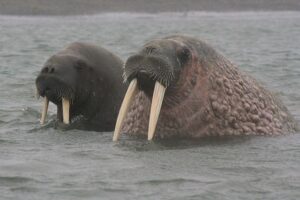
Walrus in the mist, two Walrus in a large group of near a haulout in Svalbard, photo by LindsayRs, 11 July 2005, CCA 2.0 Generic license, Flickr.
traditional carving of marine mammal ivory is also an essential part of many indigenous groups’ annual income. TRAFFIC also reported that in the five-year period between 2005 and 2009, there were 772 walruses recorded in international trade, about 125 per year.
A 2014 TRAFFIC report noted that an addition to the current documentation program in which walrus was traded only with certificates or holographic stickers could readily be introduced. Such a system would render any illegal trade in carved walrus ivory untenable and ensure that populations were not at risk.[5]
The Summary of Responses states that according to TRAFFIC, “neither illegal hunting nor illegal trade appear to be at levels that would cause conservation concern for most walrus range states”…however, “the lack of long-term data and poor quality of information on population estimates for walrus makes it difficult to determine whether the harvest and resulting international trade will affect the conservation of the species.”
Illegal hunting and trade are not a threat to Narwhal populations, climate change is.
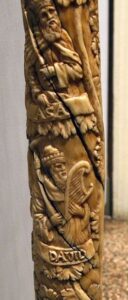
Narwhal tusk, Tree of Jesse, 16th C. Museo Correr Narval, photo Vassil, 3 March 2015, CCO 1.0 Universal Public Domain Dedication.
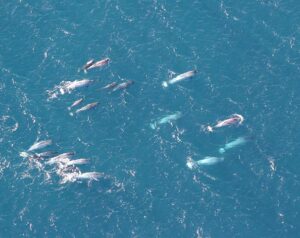
A pod of narwhals (Monodon monoceros) off Greenland, 2016, photo by Dr. Kristin Laidre, Polar Science Center, UW NOAA/OAR/OER.
The narwhal is the only marine mammal (or cetacean) with a long spiraled tusk, sometimes reaching over eight feet in length. The tusks, always rare, were once thought to have come from unicorns.
The Summary of Responses states that TRAFFIC reports that illegal hunting and trade “do not appear to be a widespread concern for most narwhal range states. In instances where they may occur or are reported, management actions are taken by authorities. They also conclude that according to available data, there is no indication that international trade is currently a threat to the conservation of narwhals.”
Narwhals are considered one of the marine mammals most threatened by climate change. In winter, narwhals live in frozen regions where 95% of the water surface is ice. In 2015, there were thought to be about one hundred thousand narwhal, most of them in Baffin Bay between Baffin Island and the west coast of Greenland.[6]
Only Inuit are permitted to hunt narwhals in Canada and Greenland; communities are set a quota of from five to 50 animals. The Inuit communities in Canada use only 73-88% of the quota of hunted narwhal they are allowed each year. Narwhal cannot be legally possessed, traded, or transported from one Canadian province to another unless a Marine Mammal Tag is attached to the tusk or carcass. Export requites CITES documentation.
In Greenland, hunters must apply for a license before each hunt and afterward must fill out a reporting form for every animal taken or wounded. The hunter must sign the permit which travels with the carcass or tusks when it is sold. Only professional hunters are allowed to sell meat or tusks. No export is allowed.
Trade in whale ivory is not a threat to either sperm or killer whale populations.

Scrimshaw on sperm whale tooth, Lahaina Heritage Museum, Photo by Wmpearl, 2016.
In addition to the essential role that whales play in traditional economies in the lives of both Arctic peoples and South Pacific islanders, the effect of a ban on trade in whale teeth would again be to make the circulation of antique artifacts made from them illegal. Globally, whale populations are not threatened by trade in teeth, but by the demand for meat and blubber. It can be categorically stated that whale products are no longer commercial commodities in the UK.
Iceland, Japan, and Norway are the only countries with a commercial whaling industry. There is no longer any widespread use of whale products in Europe or the US (where whale meat is illegal except in the Arctic). It is, however, a staple of the diet of Arctic peoples, and more controversially, is consumed by many people in Japan.
According to Defra’s Summary of Responses, sperm whale populations are recovering today, and killer whales are no longer hunted commercially.
“There were mixed views as to whether these species are targeted for ivory today with some respondents saying this was not the case and others submitting anecdotal evidence suggesting that beached sperm whales, killer whales and other toothed cetaceans are targeted for their teeth in several countries.”
And,
“One response stated that there is international trade in cetacean teeth, including into and from the UK, in both whole and carved teeth. However, conversely another response viewed that trade is largely in antique whale ivory with potentially some teeth salvaged from beached whales.”
Hippopotami
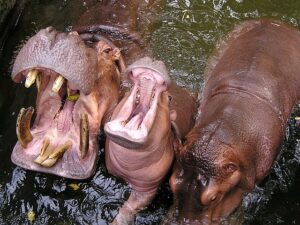
Hippopotamus amphibius, Samutprakarn Crocodile Farm and Zoo. Photo by Nasser Halaweh, 10 December 2005, CCA-SA 4.0 International license.
Hippopotamus teeth do not compete with elephant ivory, legal or illegal. International trade in the hippopotamidae (hippopotamuses) is regulated under CITES,[7] where the Hexaprotodon liberiensis and Hippopotamus amphibious are listed in Appendix II. Appendix II species are not now threatened with extinction but are at risk if their trade is not closely controlled.
There is no market for recently made hippo products in the U.S., Europe, or the U.K., and there are only a small number of antique items of hippopotamus ivory in circulation outside of Asia.
In the main, researchers in sustainable wildlife practices appear far more concerned about updating and improving overall documentation of all endangered species under CITES than about specific risk to animals that would justify the expansion of UK law.
While there is a trade in contemporary hippo teeth, it is only with Southeast Asia, Hong Kong, and China. Some environmental organizations say they are concerned that, “there is a real risk that poaching and trafficking could shift to the ivory from hippos.” This argument that there “may” be a risk increase without UK restrictions appears to be more of a moral argument against trade in wildlife per se, since the hippo market appears to be exclusively Asian and does not pertain to UK collecting or trade.
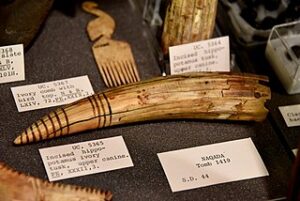
Incised hippopotamus ivory tusk, upper canine. Four holes around top. From Naqada Tomb 1419, Egypt. Naqada period. photo by Osama Shukir Muhammed Amin FRCP (Glasg), 10 March 2016, The Petrie Museum of Egyptian Archaeology, London, CCA-SA 4.0 International license.
The Summary of Responses stated in respect to hippopotami:
“Conflicting responses but no specific evidence was received as to whether with the introduction of elephant ivory bans markets might see a substitution of elephant ivory for hippopotamus ivory. Some responses argued that the high degree of similarity between hippopotamus ivory and elephant ivory, and as hippopotamus ivory commands a relatively low price, is easier to obtain, transport and carve; could result in increased trade in hippopotamus ivory as a substitute with the incentive to poach hippopotamus being higher.”
However:
“Conversely other responses considered that hippopotamus teeth are not a suitable replacement specifically in the UK as it is more brittle and does not lend itself as readily to carving. Another response viewed that the low value and small size of the tusk/tooth compared to elephant tusks alongside the continuing illegal trade in poached elephant ivory from Africa to East Asia means that it is not logical or practical for smugglers to make the switch.”
Comparing the impact of the current Ivory Law on museums and the market
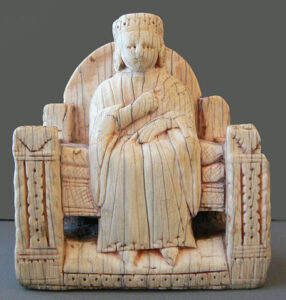
Chess Figure from Italy or Central Europe, ivory or walrus teeth; 12th to 16th century, Photo by Andreas Praefcke, Bode-Museum Berlin, public domain.
US, UK and European trade in new ivory in most cases does not exist; the trade is limited to antiques. From the marketplace perspective, virtually all art dealers and collectors outside of Asia support the ban on new elephant ivory and there would be no effect on their businesses to ban the marketing of new ivories from other animals as well.
Musicians and musical instrument dealers, repairers and restorers have replaced elephant ivory with other currently legal substitutes including mammoth ivory. Since mammoth ivory appears to have been taken off the list of animals in the proposed legislation, it should continue to be available for musical instrument repairs in the UK. Therefore, the greatest concern about the effect of an expansion of ivory law is that it would make it more difficult to preserve antique examples of art and musical instruments made from or restored with these ivory materials.
The UK government has ensured access to some elephant ivory objects for public museum collections by allowing legal sales of elephant ivory items to museums and from one museum to another. There is a very narrow exemption allowing sales in the market of the ‘rarest and most significant items of their type’ of objects over 100 years of age – with official approval. The way in which the law is written gives UK museums a considerable ‘edge’ in acquiring ivory objects at the price they want, since if they are not certified by museum-based experts as qualifying as the rarest of the rare, they can only be sold to a museum.
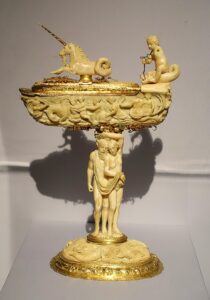
Unicorn (narwhal) cup and cover, Germany, Augsburg or Nuremberg, late 1600s, narhwal tusk, gilt silver, photo by Daderot, 6 February 2020, Metropolitan Museum of Art, NY, CCO 1.0 Universal Public Domain Dedication.
Market representatives strongly objected to including antiques in the ban against elephant ivory. They argued that halting trade in raw ivory and new carvings was what was essential to preserve elephants from extinction. They also made the point that severely restricting the trade in ancient and antique items was likely to result in the destruction of hundreds of thousands of works of art, knickknacks and antique items that did not qualify for legal sale, and if valueless, would simply be thrown away, damaged, or destroyed.
In December 2018, Dr. David Roberts, Academic Head of Conservation Biology in the School of Anthropology and Conservation at the University of Kent, described the Ivory Law as “a bit of a PR stunt” with little or no effect on the poaching of elephants.
Dr. Roberts was also critical of expanding the Ivory Law to cover non-elephant ivories:
“People no longer hunt toothed whales to any degree and certainly not for their teeth, therefore why ban a trade in what is largely antique or with potentially some beach salvaged teeth? Banning walrus and narwhal will disenfranchise communities in the Arctic who have few resources due to the environmental conditions. The only potential issue is hippo where the current ban on elephant ivory could move the attention of poachers as a source. However, hippo populations are still comparatively large and could be managed.”
So far, it appears that UK restrictions on antique ivory is likely to discourage preservation of objects without preserving animal species. Many people in both the US and UK who have inherited ivory or collected antique ivory objects such as Japanese netsuke or Art Deco sculptures do not now know what to do with them. Museums already have significant ivory collections and few are willing to accept objects as gifts unless they are of extraordinary quality.
Will that also be the fate of collections of art from the island nations of the South Pacific, where both whale teeth (on the prohibited list) and carved whalebone (not on the list) are integral to traditional ornament? Such antique goods travel in international trade, but in the largest markets of Europe, the UK and US, import and export is already highly restricted under CITES (and in the US, the Marine Mammal Act) and every import required extensive written provenance and documentation, and is scrutinized by both customs and endangered species authorities.
Preserving animal populations is a crucial goal, as is preserving access to artworks made in ages past from animal source materials. Based on the data supplied through wildlife experts and conservation organizations, individuals and governments can make rational decisions that honor both the goals of sustainability and of preservation of objects of historical value, and both can be saved.
[1] Today, the Ivory Act only covers elephant ivory. It so strictly limits the trade in objects made of or containing ivory, of any age, as to be a virtual ban on all ivory trade. If the law is expanded, similarly limited exceptions might be considered for ivory from other species: pre-1947 items with less than 10% ivory by volume; pre-1975 musical instruments with less than 20% by volume; pre-1918 portrait miniatures.
Museums, collectors, and the art trade have strongly supported bans on new ivory. However, the most severe impact of the Ivory Law is likely not to be to protect endangered species but instead to eliminate the legal antiques trade in objects 100 years old or more, including in medieval, Renaissance, and other pre-modern artworks and furnishings. The ivory ban will also make many antique Japanese, Chinese, Islamic and Indian works of art made wholly or partially of ivory unsaleable in the UK.
[2] The Convention in International Trade in Endangered Species.
[3] Marine Mammal Protection Act, 16 U.S.C. §1361-1407 (1972) The 1972 US Marine Mammal Protection Act protects sea otter, walrus, polar bear, dugong, and manatee. The Act prohibits the taking and trading of marine mammals and their products but allows certain exemptions under State management. New marine mammal ivory may be carved only by Alaska Natives and sold only after it has been carved. Old ivory can be carved by non-Natives. Fossilized mammoth ivory may be used by both Alaska Natives and non-Natives. Beach-found ivory is legal to own if registered, but cannot be bartered or sold. Fossil ivory may not be collected on any State or federal lands but may be collected on private lands with permission of the owner.
[4] Hauling Out: International Trade and Management of Walrus, by Tanya Shadbolt, Tom Arnbom, and Ernest W.T. Cooper, A TRAFFIC Report, World Wildlife Fund, 2014.
[5] Id., p.7.
[6] Breaking the Ice: International Trade in Narwhals, in the Context of a Changing Arctic, by Tanya Shadbolt, Ernest W.T. Cooper, and Peter J. Ewins, A TRAFFIC and WWF-CANADA Report, World Wildlife Fund, 2015.
[7] How CITES Works, “All import, export, re-export and introduction from the sea of species covered by the Convention has to be authorized through a licensing system… The species covered by CITES are listed in three Appendices, according to the degree of protection they need.” https://www.cites.org/eng/disc/how.php
Additional reading: Collaborative Exhibit at LACMA – Fiji: Art & Life in the Pacific, Cultural Property News, January 31, 2020
- Consultation on extending the Ivory Act to other species – consultation document.pdf159.8 KB (PDF document)
- Consultation on extending the Ivory Act to other species – respondee letter.pdf101.8 KB (PDF document)
- Call for Evidence on Non Elephant Ivory Trade
- Summary of responses from Call for Evidence
- 25 Year Environment Plan
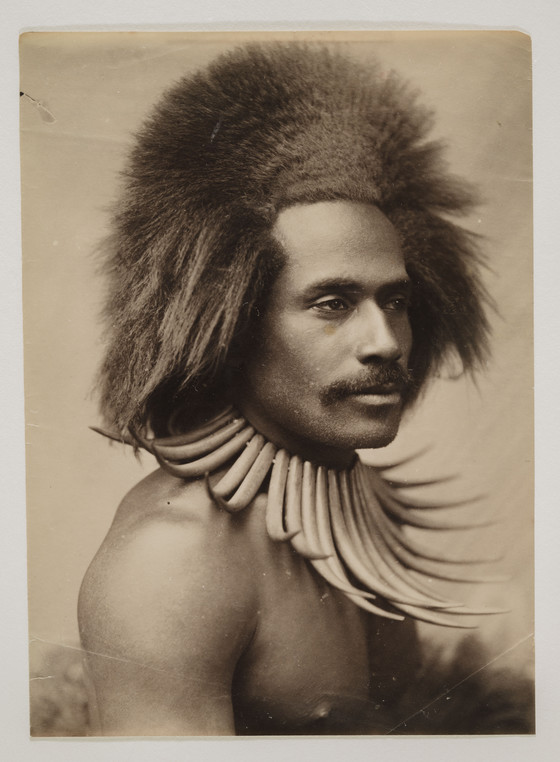 Fijian Warrior (with whale tooth necklace), Photo by John William (J.W.) Waters, 1884, albumen print, Partial gift of Mark and Carolyn Blackburn, Los Angeles County Museum of Art, public domain.
Fijian Warrior (with whale tooth necklace), Photo by John William (J.W.) Waters, 1884, albumen print, Partial gift of Mark and Carolyn Blackburn, Los Angeles County Museum of Art, public domain. 

